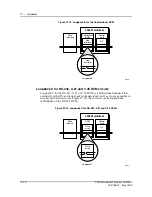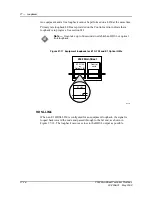
27 — Loopbacks
27-2
2902 MainStreet Technical Practices
90-2906-01 May
2002
27.1
Using loopbacks
A loopback is a maintenance function used to isolate faults in equipment and
transmission lines. A signal is sent out from a test point and looped back at some
other point along the transmission path. The outgoing signal is compared to the
returning signal using external test equipment.
The 2902 MainStreet system provides several types of loopbacks so that the signal
can be returned at different points in the path. This allows you to check progressively
longer sections of the transmission, knowing that the fault can be found between the
last successful loopback and the first unsuccessful loopback.
Up to five loopbacks can be active simultaneously. When this number is reached,
loopback softkeys do not appear for circuits without a loopback and the display
shows a cautionary message.
All loopbacks are temporary in the sense that loopback information is not stored in
non-volatile memory.
Types of loopbacks
The 2902 MainStreet system performs loopbacks on circuits (primary rate and data)
and primary rate links.
Loopbacks on primary rate and data circuits can be unidirectional or bidirectional,
and can include loopbacks A, B, C or E.
Loopbacks on primary rate links include equipment and line loopbacks.
Bidirectional and unidirectional loopbacks
Loopbacks are either bidirectional, unidirectional or unidirectional with
pass-through (see Figure 27-1).
Caution —
Initiation of a loopback causes all calls in progress on the
affected circuit to be dropped. No new calls can be initiated on the
circuit while it is looped back.
Note 1 —
Maintenance on the module in physical position M2 is
accessed through NMTI module position 9.
Note 2 —
Maintenance information on module position 9 is not
available when position 9 is disabled by position 1 (during a
super-rate connection). See section 19.11 in
Configuration
for details.
Note 3 —
Selecting UNDO_MAINT does not disable background
diagnostics, halt directed diagnostics, affect the state of the signaling
leads, or remove a primary rate link loopback.
Caution —
For Loopback B, loss of input cannot be detected while
the loopback is in progress, and no action can be taken until the
loopback is removed.
Summary of Contents for MainStreet 2902
Page 1: ...2902 MainStreet Network Termination Unit Release 1 0 H T E C H N I C A L P R A C T I C E S ...
Page 40: ...3 Mounting the unit 3 8 2902 MainStreet Technical Practices 90 2906 01 May 2002 ...
Page 50: ...4 Ground and power connections 4 10 2902 MainStreet Technical Practices 90 2906 01 May 2002 ...
Page 68: ...6 Connecting to the network 6 4 2902 MainStreet Technical Practices 90 2906 01 May 2002 ...
Page 90: ...7 Connecting to data devices 7 22 2902 MainStreet Technical Practices 90 2906 01 May 2002 ...
Page 108: ...10 Node management 10 10 2902 MainStreet Technical Practices 90 2906 01 May 2002 ...
Page 150: ...14 CPSS 14 6 2902 MainStreet Technical Practices 90 2906 01 May 2002 ...
Page 218: ...20 Codirectional DCM 20 6 2902 MainStreet Technical Practices 90 2906 01 May 2002 ...
Page 234: ...22 HCM rate adaption 22 10 2902 MainStreet Technical Practices 90 2906 01 May 2002 ...
Page 246: ...23 Cross connecting circuits 23 12 2902 MainStreet Technical Practices 90 2906 01 May 2002 ...
Page 254: ...24 Visual indicators 24 8 2902 MainStreet Technical Practices 90 2906 01 May 2002 ...
Page 266: ...25 Alarms 25 12 2902 MainStreet Technical Practices 90 2906 01 May 2002 ...
Page 278: ...26 System diagnostics 26 12 2902 MainStreet Technical Practices 90 2906 01 May 2002 ...
Page 298: ...27 Loopbacks 27 20 2902 MainStreet Technical Practices 90 2906 01 May 2002 ...
Page 332: ...Glossary GL 8 2902 MainStreet Technical Practices 90 2906 01 May 2002 ...
Page 343: ......
Page 344: ... 2002 Alcatel All rights reserved 90 2906 01 95 1820 01 00 C ...
















































